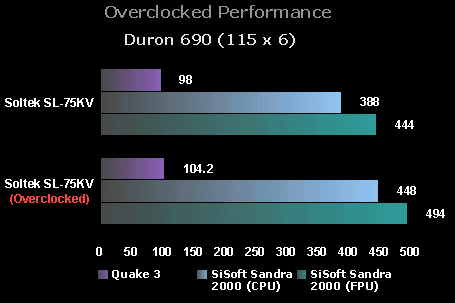
|
Plagued by numerous problems in the recent past, Intel now sees itself in a very difficult position. Quite a contrast from the days before the existance of the Athlon. Since the Athlon's conception, AMD has been moving forward at full speed and minimal hindrance many thanks to the vast pool of chipset and motherboard support.
80% Rating: 
|
|
|
|
Home >
Reviews >
Motherboards >
Soltek 75KV |
|
|
Overclocking and Stability
With respect to overclocking, the
SL 75KV comes packed with a number of options to assist the user. Available
front side bus (FSB)
speeds on this motherboard range from 100MHz 150MHz which can either be modifying
from within the system BIOS or through the use of its on
board DIP switch box. Specifically, the SL 75KV supports the following FSB's: 100, 103, 110, 112, 115,
120, 124, 133, 140 and 150MHz.
These speeds are selectable either through the DIP switches or BIOS
through the Frequency/Voltage Control option. However, for all practical
purposes the SL 75KV does support increases of FSB speed in very small steps of
1MHz. This is done by first setting a FSB speed through whichever means
available. Then, two options known as "Method in Linear Function" and "CPU Host
by Linear Function" allow the user to either add or subtract a value between
0 28MHz to/from the already set FSB speed.
Another attraction for
overclockers is the option to manipulate core voltage value of the CPU. Starting
from 1.50V, the SL 75KV allows Vcore to go as high as 1.85V in 0.025V
increments. And of course, an option to boost the memory bus by 33MHz (over FSB)
is available.
Unfortunately, this board does not provide for the much needed multiplier
adjustment. As Duron's and T Birds are notorious for their overclocking
potential through this avenue, it would have been ideal for Soltek to include
such a feature. This being the case, we did not even hope to reap any
substantial benefit from the SL 75KV.

And the result to our
expectations was that we were partially correct. Previously, we were able to get
a throbbing 950MHz out of the Asus A7V through the use of multipliers. A 672MHz
overclock (112 x 5) was attainable on a Biostar mobo. Fortunately, the Soltek
was able to secure a very stable 690MHz (115 x 6) under all applications. The
reason I say this is because we were able to get a 714MHz (119 x 6) overclock
running in all applications except for those which are graphics intensive. In
such applications, frequent crashes were the result hence forcing us to come
down to a 115MHz FSB.
Overall, the overclocking potential of this is much
better than what the Biostar had exhibited but without a multiplier adjustment,
the full potential of this otherwise very stable board is still to remain
in darkness.
Conclusions
Thinking back to our earlier Soltek reviews and keeping this one
in mind as well, it is clear that they have developed a consistent record for
making high performing and very stable motherboards. This makes Soltek
motherboards quite ideal for server use where mission critical applications are
centralized. The added AGP Pro slot also gives the SL 75KV an added attraction
towards graphics professionals. In fact, the availability of such a slot on a
Socket A motherboard is quite rare. Hardcore overclockers and hobbyists may want
to look at other options which are available.
The addition of 2 extra USB
ports, another rarity among Socket A boards, adds a good amount of flexibility
to the end user. The lack of an AMR slot an the addition of a single ISA slot
makes this accommodation more feasible as AMR just has yet to
click.
All in all, Soltek have done a very good job in designing such a
well rounded motherboard. From what we have seen of them so far, it doesn't look
at if they are going astray from being at the top of their
game.
|
